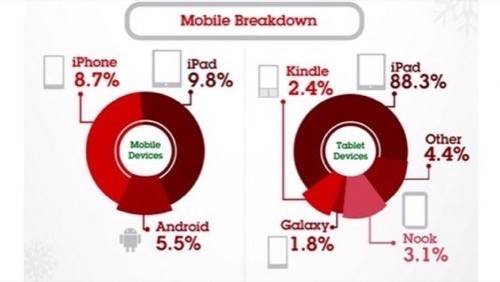
Hey kids! This week’s theme is “shop till you drop!” Brought to you by the letter “M” for “mobile.”
As expected, online sales, purchases and deals were much bigger for Thanksgiving, Black Friday and now Cyber Monday than they were a year ago. Also as expected, people are turning more to their smartphones and tablets more and more for their shopping experiences.
It seems like we have heard this story before.
Oh right, we have.
The Song Remains The Same
From a reporter’s perspective, few things are more infuriating than writing basically the same damn stories year after year after year: “Online shopping is super popular this year, way more popular than last year! Now look! More people are using their smartphones to shop too!”
There is a Thanksgiving glutton’s amount of data surrounding the increase in online sales and mobile shopping this year. PayPal and its parent eBay tout that eBay saw a 153% increase in mobile volume transaction on Black Friday with PayPal seeing a 193% in mobile payment volume that day. It is interesting to note what PayPal considers a “mobile payment” since the company is only now building out its presence in brick-and-mortar retail spaces. The “Pay with PayPal” button has long been on many e-commerce websites, but if this counts as mobile payment volume, then there is little difference between shopping using your smartphone or tablet and using your PC. One way or another you are using a device to connect to the Internet and shop. A PayPal spokesperson notes that the company considers a mobile payment to be, “any payment made on a mobile device, including tablets.”

According to IBM Digital Analytics Benchmark, shoppers in the United States took advantage of early promotions this year, constituting a 21% increase in online sales over 2011. The one-fifth growth in online shopping is impressive, indeed, but not surprising or jaw dropping. For years we have watched people turn to the Web for deals and shopping – it would be shocking only if those online and mobile sales numbers dropped.
IBM notes that mobile sales reached 16% this year, up[ from9.8% for 2011. Nearly 24% of consumers used a mobile device to visit a retailer’s online website this year, compared to 14.3% last year. The iPad generated more traffic than any other tablet or smartphone, reaching 10% of online shopping and 88.3% of all tablet shopping traffic. The Barnes & Noble Nook was second, with 3.1% of volume, ahead of the Kindle Fire at 2.4%. Those numbers likely discount Amazon’s own internal data of people using Fire tablets to shop specifically on Amazon as opposed to traffic to retailers’ websites.
“Showrooming” Still Zooming
The buzz phrases that we saw take root during the 2011 shopping season have grown proportionately with the rise of mobile usage in 2012. “Showrooming,” the act of looking up prices from your smartphone when at a physical retail space, has grown significantly this year. IBM notes that 58% of consumers used smartphones on Black Friday (41% used tablets) to shop. It is likely that many of those consumers were using their smartphones to shop while standing inside a brick-and-mortar store, checking prices online against what was posted on the shelf.
The concept of “couch commerce” has also taken off in the past two years. This is usually specifically tablet-related as consumers use their slates to peruse deals from their couch, often on Thanksgiving Day itself. Several research studies and surveys have been conducted, by Pew among others, studying how people use their tablets on a day-to-day basis. The consensus has been that tablets are considered to be the quintessential couch device as people interact with news, media, games, social and other activities from their couches. It is then understandable that people would shop from their couches with their tablets as well.
Fundamentally, what we are seeing from all of this Black Friday (and probably Cyber Monday) shopping data is that people are performing the same activities they historically would, just from a different device. As the Digital Age and the Mobile Revolution collide, we see more services (such as apps, mobile-specific websites, price checkers, shopping companions and deals sites) converge and grow.
Deja Vu All Over Again
Here’s the thing. A year from now, when the 2013 Holiday shopping season rolls around, we are going to be bombarded with the exact same types of stories about changing consumer behavior and growth statistics. The bottom line is that better tools for consumers make for more savvy shoppers. A high tide raises all boats, as the saying goes.
Did you use your smartphone or tablet to augment your shopping experience this year? If not yet, are you planning to? How so? Let us know in the comments.
Top image: Breakdown of mobile shopping by device courtesy of IBM.

















